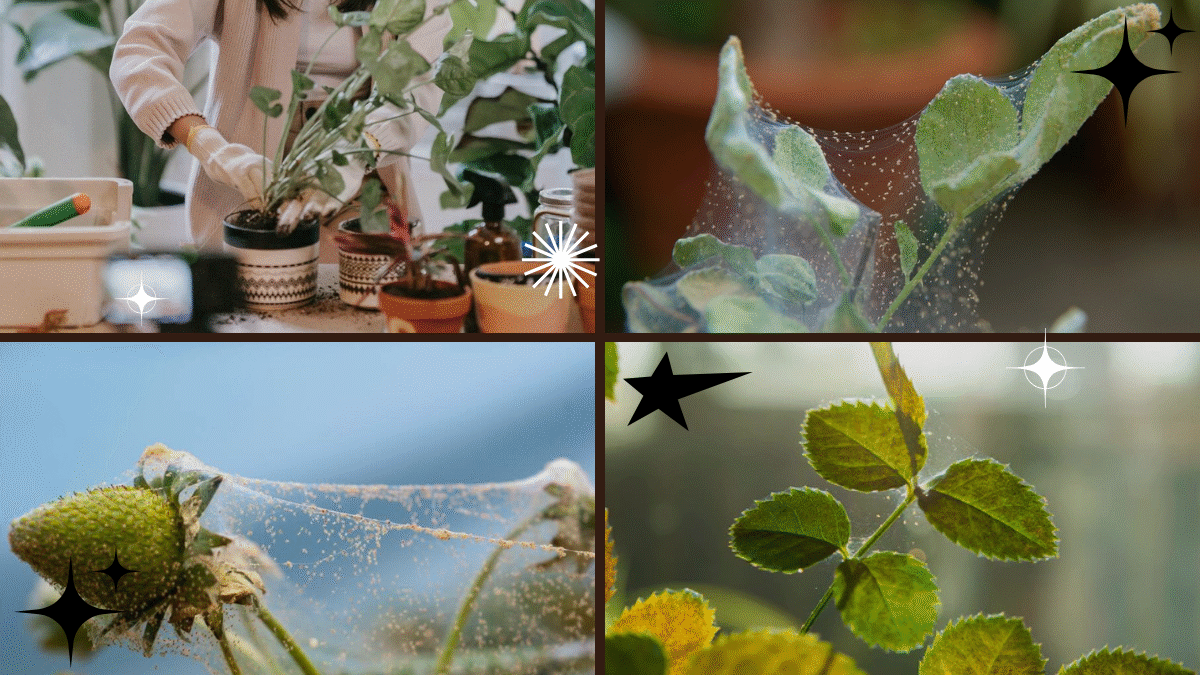Indoor plants have a magical way of transforming your living space — they purify the air, elevate your mood, and add natural beauty to any room. But nothing puts a damper on your leafy paradise like a pesky infestation of spider mites. These tiny, sap-sucking pests can quickly turn your thriving plants into sickly, sad specimens. The good news? You can get rid of spider mites naturally and effectively.
In this guide, you’ll discover how to identify, treat, and prevent spider mites so your indoor jungle stays lush and healthy all year round!

What Are Spider Mites?
Spider mites are tiny, spider-like pests from the Tetranychidae family. Despite their size — most are less than 1 mm long — these insects can do serious damage. They’re notorious for hiding on the undersides of leaves and spinning delicate, silk-like webs around plant foliage.
Spider mites feed on plant sap by piercing leaf tissue, which results in stippled, yellowing leaves, and overall plant stress. If left untreated, heavy infestations can cause leaf drop, plant stunting, and even death.

Why Are Spider Mites a Problem for Indoor Plants?
Spider mites thrive in warm, dry indoor environments, making homes and offices prime territory. Factors that attract them include:
- Low humidity
- Overcrowded plant arrangements
- Dry air from heating systems
- Neglected plant hygiene
Their rapid reproductive rate is another challenge — a single female spider mite can lay hundreds of eggs in just a few weeks!

How to Identify a Spider Mite Infestation
Catching spider mites early is key to protecting your plants. Here’s what to look for:
Visual Signs:
- Tiny specks or dots (white, red, yellow, or brown) moving on the underside of leaves.
- Fine, silky webbing around leaves and stems.
- Yellowing or stippled leaves — tiny pale spots or silvery patterns on leaf surfaces.
- Leaves curling, drying, or falling off prematurely.
The Paper Test:
Hold a white sheet of paper under a leaf and gently tap the leaf. If tiny moving specks fall onto the paper, you likely have spider mites.

How to Get Rid of Spider Mites Naturally and Effectively
There’s no need to reach for harsh chemicals. With consistency and the right methods, you can safely tackle spider mites and restore your plant’s health.
1. Isolate the Affected Plant
First, move infested plants away from your other indoor greenery to prevent the mites from spreading. Spider mites are tiny and travel quickly via air currents, hands, and tools.
2. Rinse the Plant Thoroughly
A strong, targeted spray of water can dislodge spider mites from leaves and stems.
- Use a showerhead, hose, or sink sprayer to rinse your plant — paying special attention to leaf undersides.
- Repeat this process every few days to reduce mite numbers.
3. Wipe Leaves with a Soapy Water Solution
Soapy water works by breaking down the mites’ outer shells, killing them on contact.
Recipe:
- Mix 1-2 teaspoons of mild liquid dish soap (free of degreasers or antibacterial agents) into 1 liter of lukewarm water.
How to Apply:
- Dip a soft cloth in the solution and gently wipe both sides of each leaf.
- Alternatively, mist the plant with the mixture using a spray bottle.
- Rinse with clean water after a few hours to prevent soap buildup.
Repeat every 3-5 days for 2-3 weeks.
4. Apply Neem Oil Spray
Neem oil is a powerful, natural insecticide and miticide derived from the neem tree.
Neem Oil Spray Recipe:
- Mix 2 teaspoons of neem oil, 1 teaspoon of mild dish soap, and 1 liter of warm water in a spray bottle.
- Shake well and spray the entire plant, including stems and the underside of leaves.
Repeat once a week until mites are gone.
Neem oil not only kills active mites but also disrupts their life cycle by preventing egg hatching.
5. Use Insecticidal Soap or Horticultural Oil
Available at garden centers, insecticidal soaps and horticultural oils like canola or mineral oil are safe for most houseplants and effective against spider mites.
- Spray generously over the entire plant, focusing on affected areas.
- Reapply according to label instructions, usually every 7-10 days.
6. Introduce Natural Predators
If you have a larger indoor plant collection or a greenhouse space, beneficial insects like predatory mites (Phytoseiulus persimilis) can help control spider mite populations.
- These tiny allies feed on spider mites without harming your plants.
- Available from garden suppliers or online.
7. Prune Heavily Infested Leaves
Remove and dispose of badly infested leaves or stems to reduce the mite population quickly.
- Use sterilized scissors or pruners.
- Discard clippings in a sealed plastic bag — not in your compost pile!
How to Prevent Spider Mites on Indoor Plants
Once you’ve cleared up an infestation, prevention is the best strategy to avoid future problems.
Increase Humidity
Spider mites hate humid conditions.
- Mist plants lightly, especially those like ferns and calatheas.
- Use a humidity tray filled with pebbles and water beneath your pots.
- Group plants together to create a naturally humid microclimate.
Clean and Inspect Plants Regularly
- Wipe down leaves with a damp cloth every few weeks.
- Check leaf undersides for mites or eggs.
- Rinse plants occasionally in the shower.
Quarantine New Plants
Always isolate new plants for 7-10 days to watch for pests before adding them to your collection.
Avoid Overcrowding
Give plants ample space to promote air circulation, which deters mite infestations.
Use Clean, Sterile Potting Mix
Dirty or reused soil can harbor mites and eggs. Always use fresh, sterile potting mix for repotting.
Best Indoor Plants Prone to Spider Mites
Some plants are more vulnerable than others, especially those with fine, tender leaves. Keep a close eye on:
- Fiddle Leaf Fig
- English Ivy
- Calatheas
- Rubber Plants
- Palms
- Spider Plants
Regular inspections can catch mite issues early in these sensitive species.
Final Thoughts
While spider mites might be small, they can quickly cause big problems in your indoor garden. The key to successfully managing them lies in early detection, consistent care, and natural remedies like neem oil, soapy water, and beneficial predatory mites.
With these practical, chemical-free solutions and a few smart preventative habits, you can keep your indoor jungle lush, healthy, and thriving — free of web-spinning pests.





Leave A Comment